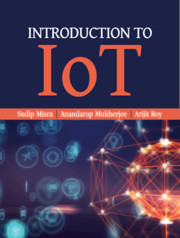10 - Cloud Computing
Published online by Cambridge University Press: 09 January 2021
Summary
Learning Outcomes
After reading this chapter, the reader will be able to:
Understand the concept of cloud computing and its features
Understand virtualization, different cloud models, and service-level agreements (SLAs)
Identify the salient features of various cloud computing models
Understand the concept of sensor-clouds
Introduction
Sensor nodes are the key components of Internet of Things (IoT). These nodes are resource-constrained in terms of storage, processing, and energy. Moreover, in IoT, the devices are connected and communicate with one another by sharing the sensed and processed data. Handling the enormous data generated by this large number of heterogeneous devices is a non-trivial task. Consequently, cloud computing becomes an essential building block of the IoT architecture. This chapter aims at providing an extensive overview of cloud computing. Additionally, Check yourself will help the learner to learn different concepts are related to cloud computing.
Cloud computing is more than traditional network computing. Unlike network computing, cloud computing comprises a pool of multiple resources such as servers, storage, and network from single/multiple organizations. These resources are allocated to the end users as per requirement, on a payment basis. In cloud computing architecture, an end user can request for customized resources such as storage space, RAM, operating systems, and other software to a cloud service provider (CSP) as shown in Figure 10.1. For example, a user can request for a Linux operating system for running an application from a CSP; another end user can request for Windows 10 operating system from the same CSP for executing some application. The cloud services are accessible from anywhere and at any time by an authorized user through Internet connectivity.
Points to ponder
Gmail, Facebook, and Twitter are examples of cloud computing applications.
Currently, many companies such as Amazon Web Service and Microsoft Azure provide cloud services.
Cloud computing comprises a shared pool of computing resources, which are accessible dynamically, ubiquitously, and on-demand basis by the users. This shared pool of resources includes networks, storage, processor, and servers. These resources are accessible by multiple users through a regular command-line terminal at the same or different time instants. The services of cloud computing are based on the pay-per-use model. The concept is the same as paying utility bills based on consumption. In cloud computing, a user pays for the cloud services as per the duration of their resource usage.
- Type
- Chapter
- Information
- Introduction to IoT , pp. 237 - 255Publisher: Cambridge University PressPrint publication year: 2021

